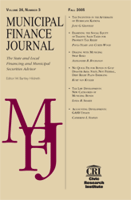A Simulation of Risk-Sharing Policies in U.S. Public Pension Plans
Author: Gang Chen.; Yimeng Yin.; Don Boyd.
Source: Volume 43, Number 01, Spring 2022 , pp.67-91(25)

< previous article |next article > |return to table of contents
Abstract:
With increasing costs and risks in public defined benefit pension plans, many U.S. state and local governments seek to share financial risks with plan members during both their working and retirement years. Risk sharing can be done by allowing pension benefits or member contributions to vary contingent on investment returns or the plan’s funded status, or it can be done by incorporating defined contribution features into defined benefit plans. The impacts of these risk-sharing policies on governments and plan members are not fully understood. This paper uses stochastic simulations to examine several typical risk-sharing policies used in public pension plans and analyzes how they affect governments’ and plan members’ costs and risks differently. The research shows that the risk-sharing policies that link cost-of-living adjustments and employee contributions to investment returns or funded status, as commonly designed, have only a moderate impact on both governments’ costs and plan members’ benefits. More dramatic risk-sharing arrangements, such as splitting actuarially determined contributions between employers and employees, and hybrid plans with defined-contribution features, have greater effects on both governments and plan members.Keywords: Public pensions, risk-sharing policy, stochastic simulation, defined benefit (DB) plans, defined contribution (DC) plans
Affiliations:
1: University at Albany; 2: Boston College; 3: University at Albany.